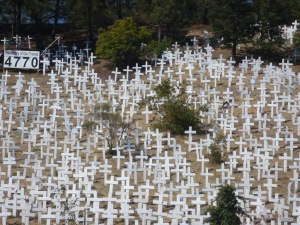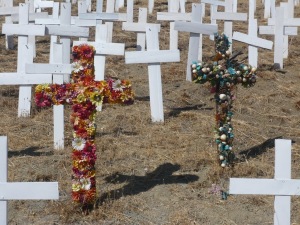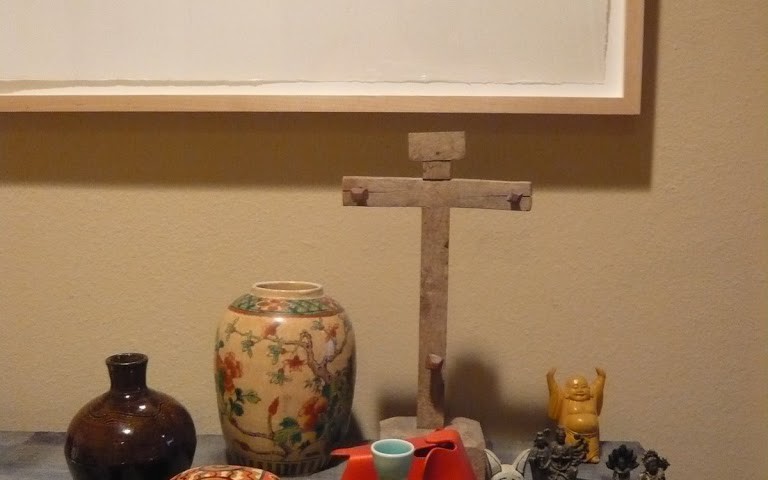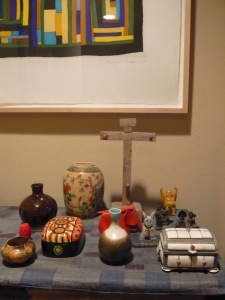All kinds of people from church-goers to gangsta-rappers wear crosses. It’s a powerful and almost universal aesthetic device that pre-dates Christianity by many thousands of years; what began as a tool for veneration of the nature god is now a piece of trendy bling.
Its ubiquity does not diminish its fascination. In the foyer to our apartment I have a simple rustic wood cross, a memento of my visits to Santa Fe, that I bought there because it reminded me of some of Georgia O’Keeffe’s paintings. Several years ago I went to an Ad Reinhardt show in
Riding east on the BART train towards the Lafayette station a hill comes into view that at first glance looks to be covered in tall white flowers; they might perhaps be lilies, or, if one’s eyesight is growing unreliable, melting snow, but within a few seconds it becomes clear enough that they are white crosses, insubstantial memorials to the dead. Yet the slope is too steep to be a cemetery, the crosses are too close together to be grave markers and are too flimsy to be permanent.
A simple black number on the hillside, like those on amateur athletic fields, is updated regularly; today the count is 4770, the number of soldiers killed in
A few days ago I returned to the site and walked around to get a closer look. There are no stickers advertising anybody or anything. A few crosses have been adopted to represent specific individuals with names, photos, jackets, beads, and flowers. While most of the crosses are white, some are multicolored, and a few are covered in mosaics or plastic flowers. Some have Islamic and Jewish symbols as well as Christian. I am reminded of the
Walking up the hill behind the crosses in the late afternoon I can see a vista that captures the essence of living here. The beautiful golden hills and oak trees in the autumn afternoon feel unchanged from my childhood, although now the transit system provides a link all the way to the airport in
 From any angle the crosses fill much of the hillside, but there is room for more. The Bush administration does not let the media show any of the soldiers killed in action nor any coffins coming home. Indeed, unless we know a combatant personally we have no way of understanding the damage to our soldiers until we see the occasional veteran interviewed on television. And those are the ones who survived. In this way, the crosses may be the simplest possible reminder of each American life lost.
From any angle the crosses fill much of the hillside, but there is room for more. The Bush administration does not let the media show any of the soldiers killed in action nor any coffins coming home. Indeed, unless we know a combatant personally we have no way of understanding the damage to our soldiers until we see the occasional veteran interviewed on television. And those are the ones who survived. In this way, the crosses may be the simplest possible reminder of each American life lost.
But again, what about the symbolism of the crosses? When I was young my family went to churches of many denominations all over the
Crosses have beautiful proportions. Ad Reinhardt painted crosses in almost all of his mature work, but he always said that he never intentionally painted anything, including crosses. He was like the artist Donald Judd – it’s just what’s in front of you. With Reinhardt, it takes a while for the eyes to adjust and see the different layers. Go slow and they come into view.
I have often wondered why Georgia O’Keeffe painted crosses so many times. Living an often solitary existence in
In this stretch of an Arcadian suburb I am moved by the grass roots spontaneity of this simple memorial that reminds commuters that individuals, over four thousand individuals and their circles of friends and family, have been devastated by this nightmare. Maybe the cross was the easiest symbol at hand. Might there be a more permanent symbol of this war and these eight years  of hubris and arrogance? The crosses on the hill don’t offer up any easy answers. But contemplating them for a few minutes in the afternoon light, like looking at Reinhardt or O’Keeffe, and wrestling with the angels and demons that make up the life of this country, may point me in the right direction.
of hubris and arrogance? The crosses on the hill don’t offer up any easy answers. But contemplating them for a few minutes in the afternoon light, like looking at Reinhardt or O’Keeffe, and wrestling with the angels and demons that make up the life of this country, may point me in the right direction.

